Comprehensive Research Report on Postilion Real-time Payment Systems
VerifiedAdded on 2022/09/13
|7
|1104
|17
Report
AI Summary
This report examines Postilion real-time systems, crucial for banks, payment processors, and card network providers. It focuses on active/active architecture for guaranteed response times and load balancing. The paper discusses sending and receiving payments using the Postilion system, a switch linking banks and credit unions, and details the role of EFT in processing financial transactions. It also explores the importance of real-time transaction monitoring solutions and the interconnectivity of various systems for optimal customer experience. The report includes an appendix with code for sending messages using the Postilion system.
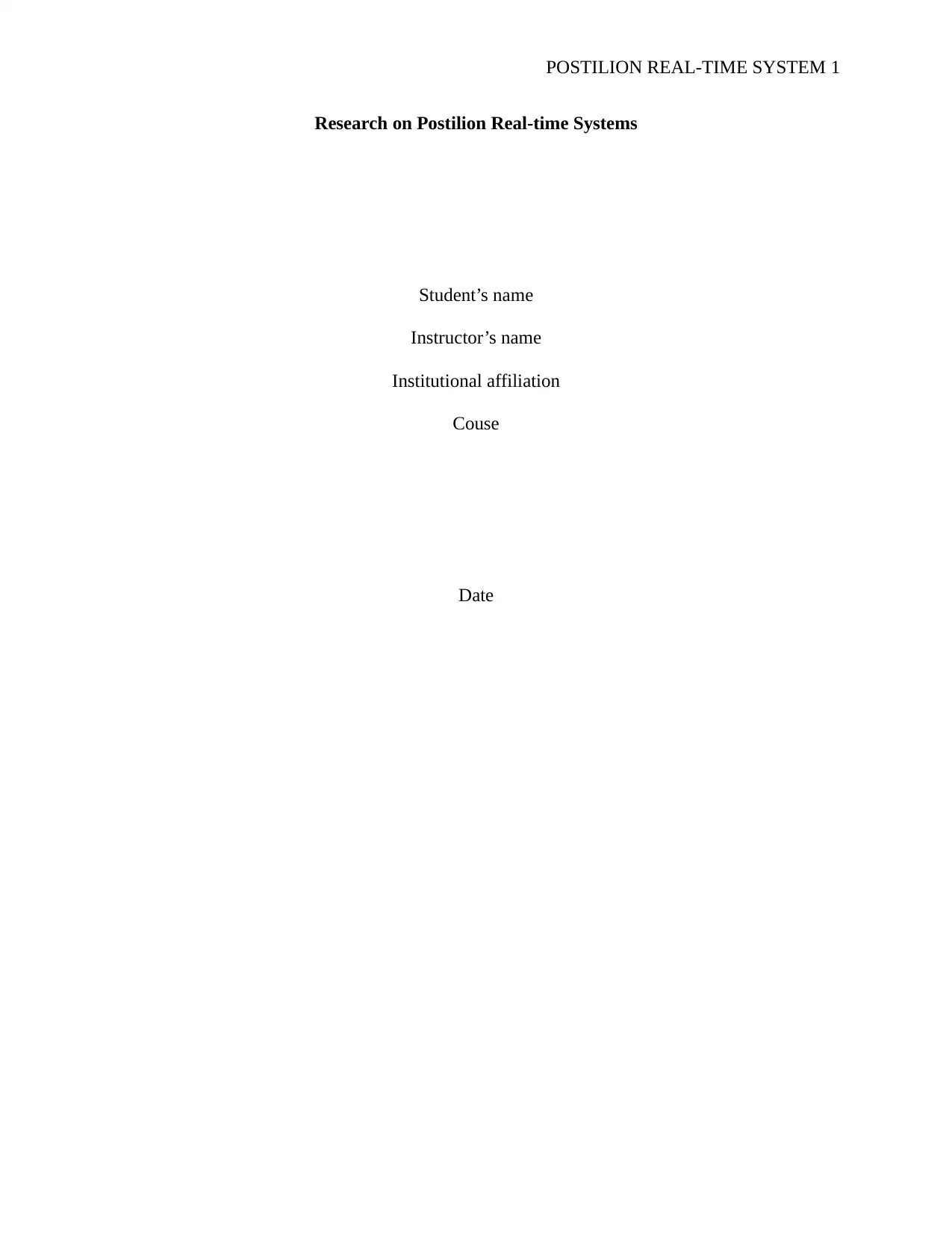
POSTILION REAL-TIME SYSTEM 1
Research on Postilion Real-time Systems
Student’s name
Instructor’s name
Institutional affiliation
Couse
Date
Research on Postilion Real-time Systems
Student’s name
Instructor’s name
Institutional affiliation
Couse
Date
Paraphrase This Document
Need a fresh take? Get an instant paraphrase of this document with our AI Paraphraser
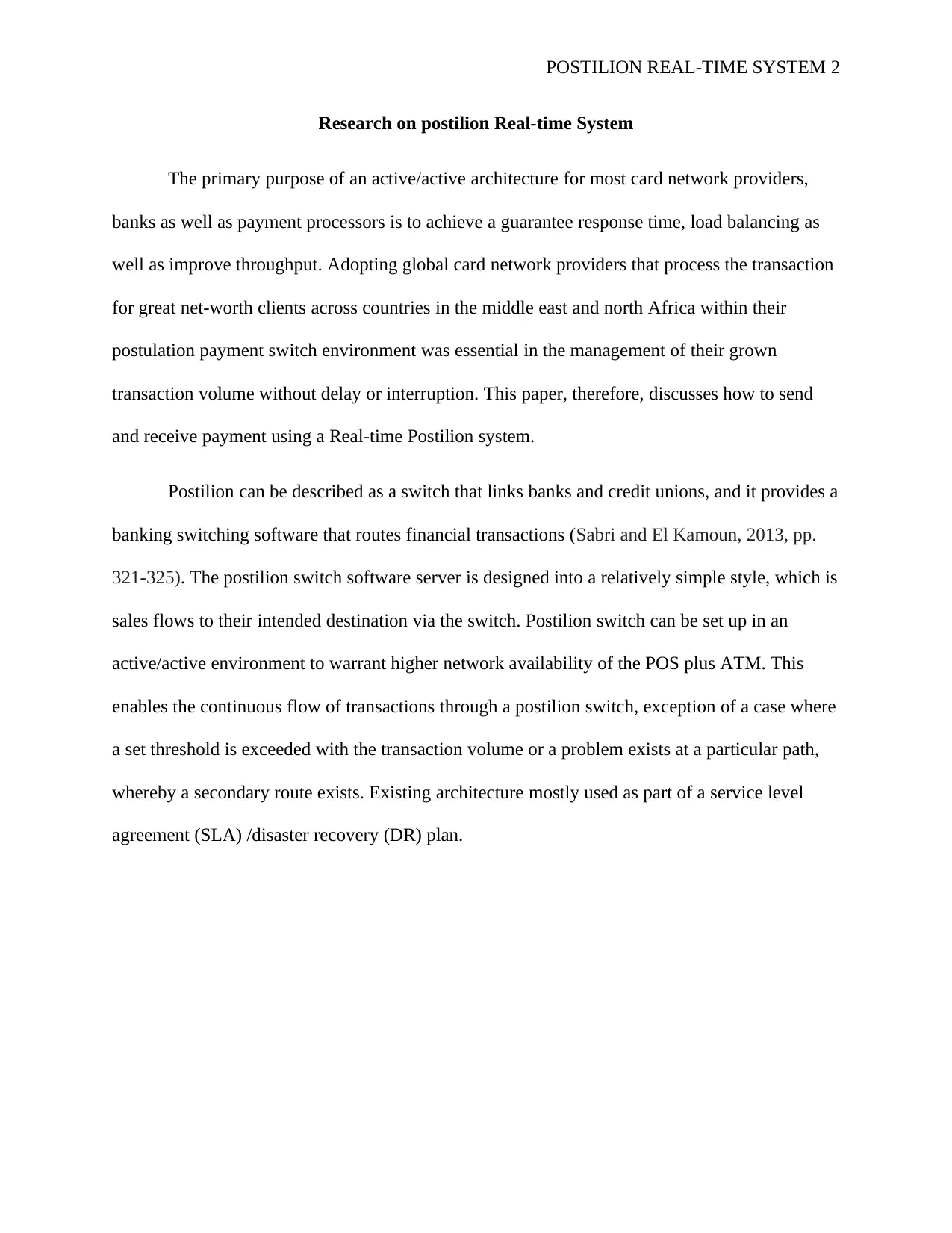
POSTILION REAL-TIME SYSTEM 2
Research on postilion Real-time System
The primary purpose of an active/active architecture for most card network providers,
banks as well as payment processors is to achieve a guarantee response time, load balancing as
well as improve throughput. Adopting global card network providers that process the transaction
for great net-worth clients across countries in the middle east and north Africa within their
postulation payment switch environment was essential in the management of their grown
transaction volume without delay or interruption. This paper, therefore, discusses how to send
and receive payment using a Real-time Postilion system.
Postilion can be described as a switch that links banks and credit unions, and it provides a
banking switching software that routes financial transactions (Sabri and El Kamoun, 2013, pp.
321-325). The postilion switch software server is designed into a relatively simple style, which is
sales flows to their intended destination via the switch. Postilion switch can be set up in an
active/active environment to warrant higher network availability of the POS plus ATM. This
enables the continuous flow of transactions through a postilion switch, exception of a case where
a set threshold is exceeded with the transaction volume or a problem exists at a particular path,
whereby a secondary route exists. Existing architecture mostly used as part of a service level
agreement (SLA) /disaster recovery (DR) plan.
Research on postilion Real-time System
The primary purpose of an active/active architecture for most card network providers,
banks as well as payment processors is to achieve a guarantee response time, load balancing as
well as improve throughput. Adopting global card network providers that process the transaction
for great net-worth clients across countries in the middle east and north Africa within their
postulation payment switch environment was essential in the management of their grown
transaction volume without delay or interruption. This paper, therefore, discusses how to send
and receive payment using a Real-time Postilion system.
Postilion can be described as a switch that links banks and credit unions, and it provides a
banking switching software that routes financial transactions (Sabri and El Kamoun, 2013, pp.
321-325). The postilion switch software server is designed into a relatively simple style, which is
sales flows to their intended destination via the switch. Postilion switch can be set up in an
active/active environment to warrant higher network availability of the POS plus ATM. This
enables the continuous flow of transactions through a postilion switch, exception of a case where
a set threshold is exceeded with the transaction volume or a problem exists at a particular path,
whereby a secondary route exists. Existing architecture mostly used as part of a service level
agreement (SLA) /disaster recovery (DR) plan.
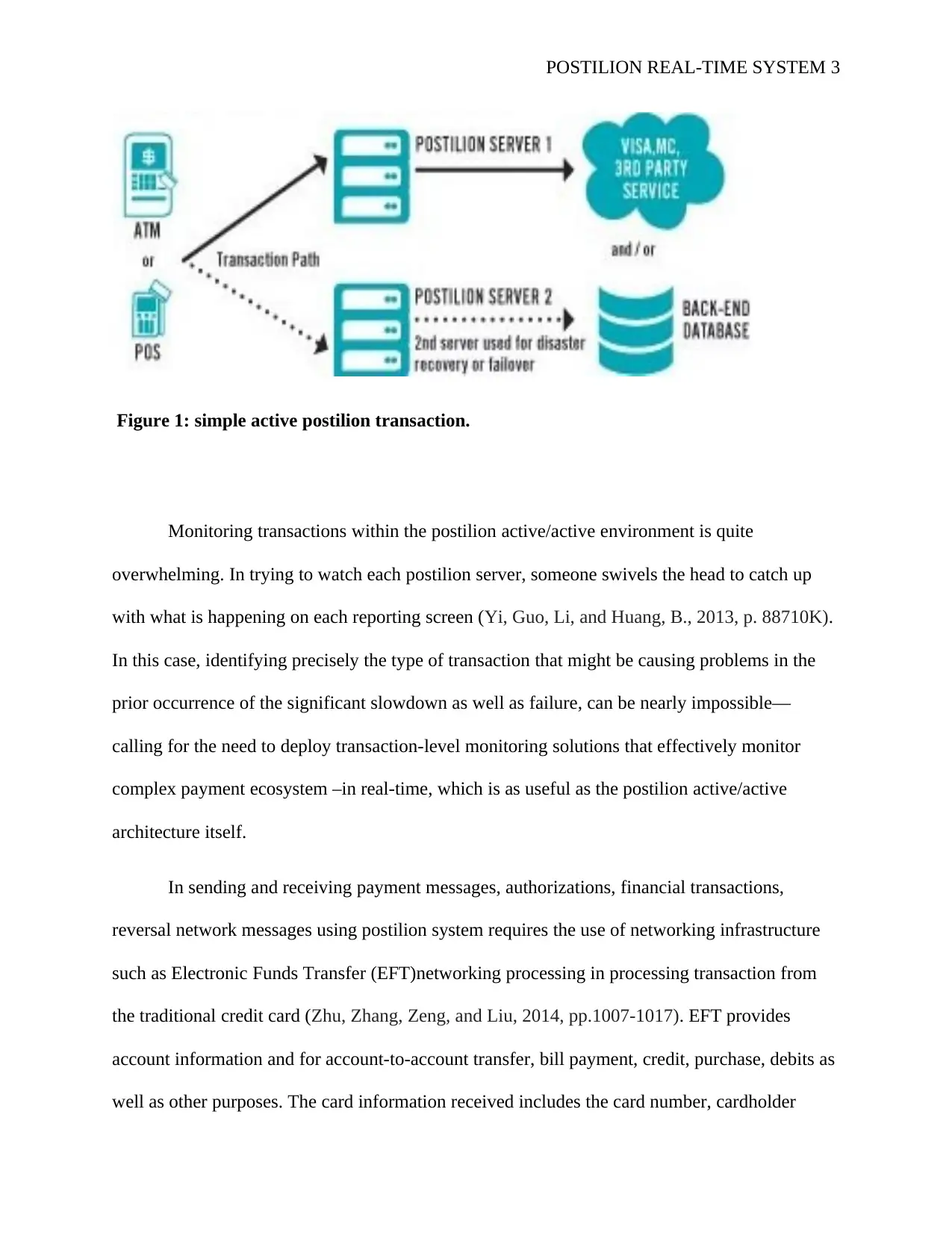
POSTILION REAL-TIME SYSTEM 3
Figure 1: simple active postilion transaction.
Monitoring transactions within the postilion active/active environment is quite
overwhelming. In trying to watch each postilion server, someone swivels the head to catch up
with what is happening on each reporting screen (Yi, Guo, Li, and Huang, B., 2013, p. 88710K).
In this case, identifying precisely the type of transaction that might be causing problems in the
prior occurrence of the significant slowdown as well as failure, can be nearly impossible—
calling for the need to deploy transaction-level monitoring solutions that effectively monitor
complex payment ecosystem –in real-time, which is as useful as the postilion active/active
architecture itself.
In sending and receiving payment messages, authorizations, financial transactions,
reversal network messages using postilion system requires the use of networking infrastructure
such as Electronic Funds Transfer (EFT)networking processing in processing transaction from
the traditional credit card (Zhu, Zhang, Zeng, and Liu, 2014, pp.1007-1017). EFT provides
account information and for account-to-account transfer, bill payment, credit, purchase, debits as
well as other purposes. The card information received includes the card number, cardholder
Figure 1: simple active postilion transaction.
Monitoring transactions within the postilion active/active environment is quite
overwhelming. In trying to watch each postilion server, someone swivels the head to catch up
with what is happening on each reporting screen (Yi, Guo, Li, and Huang, B., 2013, p. 88710K).
In this case, identifying precisely the type of transaction that might be causing problems in the
prior occurrence of the significant slowdown as well as failure, can be nearly impossible—
calling for the need to deploy transaction-level monitoring solutions that effectively monitor
complex payment ecosystem –in real-time, which is as useful as the postilion active/active
architecture itself.
In sending and receiving payment messages, authorizations, financial transactions,
reversal network messages using postilion system requires the use of networking infrastructure
such as Electronic Funds Transfer (EFT)networking processing in processing transaction from
the traditional credit card (Zhu, Zhang, Zeng, and Liu, 2014, pp.1007-1017). EFT provides
account information and for account-to-account transfer, bill payment, credit, purchase, debits as
well as other purposes. The card information received includes the card number, cardholder
⊘ This is a preview!⊘
Do you want full access?
Subscribe today to unlock all pages.

Trusted by 1+ million students worldwide

POSTILION REAL-TIME SYSTEM 4
name, expiration date. The card numbers are typically 13-19 digits long; they uniquely identify
the user credit or debit account.
Figure 2: How payment gateway work.
Upon the capturing of the card number, the merchant’s terminal sends information about
the card and the transaction. Then the payment network directs the information received to the
appropriate card issuer based on the card number (Sabri and Kamoun, 2012, pp.116-122). The
issuer then consults its records to verify the account and fund sufficiency to authorize the
transaction. The result of issuer approval is then returned to the merchant, whether able or not
able to purchase the item (Ugwu, 2016, pp,32). During this process, the cardholder gives the
merchant a uniquely identifiable card number.
In conclusion, not only in a postilion active/active architecture with multiple servers does
global card network providers need a real-time solution that could monitor a complex payment
network. But also the interconnectivity of their payment card management system, switch,
name, expiration date. The card numbers are typically 13-19 digits long; they uniquely identify
the user credit or debit account.
Figure 2: How payment gateway work.
Upon the capturing of the card number, the merchant’s terminal sends information about
the card and the transaction. Then the payment network directs the information received to the
appropriate card issuer based on the card number (Sabri and Kamoun, 2012, pp.116-122). The
issuer then consults its records to verify the account and fund sufficiency to authorize the
transaction. The result of issuer approval is then returned to the merchant, whether able or not
able to purchase the item (Ugwu, 2016, pp,32). During this process, the cardholder gives the
merchant a uniquely identifiable card number.
In conclusion, not only in a postilion active/active architecture with multiple servers does
global card network providers need a real-time solution that could monitor a complex payment
network. But also the interconnectivity of their payment card management system, switch,
Paraphrase This Document
Need a fresh take? Get an instant paraphrase of this document with our AI Paraphraser

POSTILION REAL-TIME SYSTEM 5
telecom provider, internet network, as well as the 54 third party (Back-end, POS, ATM) service
providers they relied upon. As the customer experience is paramount and even a second or
seconds improvements in transaction speed translates into significant returns.
telecom provider, internet network, as well as the 54 third party (Back-end, POS, ATM) service
providers they relied upon. As the customer experience is paramount and even a second or
seconds improvements in transaction speed translates into significant returns.
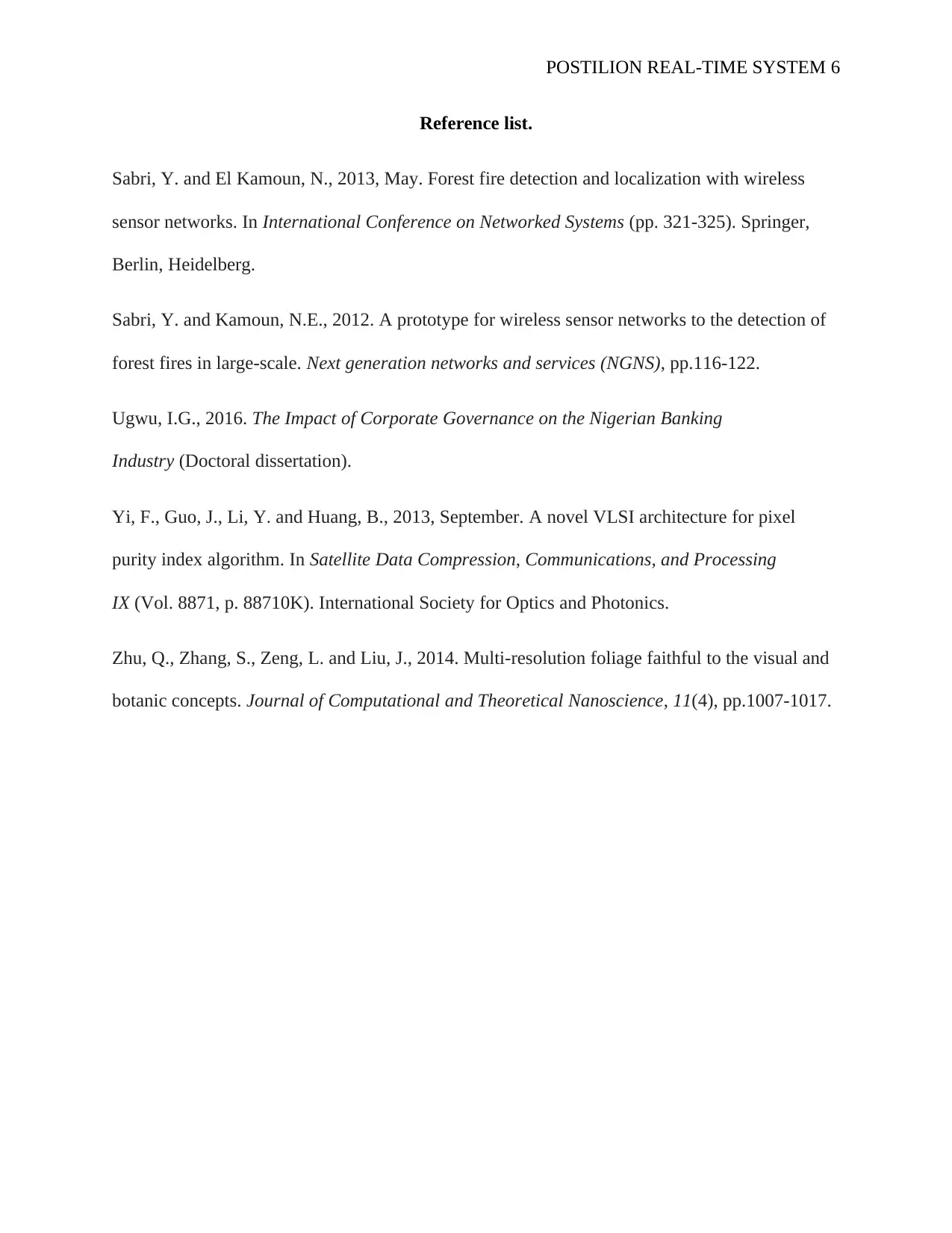
POSTILION REAL-TIME SYSTEM 6
Reference list.
Sabri, Y. and El Kamoun, N., 2013, May. Forest fire detection and localization with wireless
sensor networks. In International Conference on Networked Systems (pp. 321-325). Springer,
Berlin, Heidelberg.
Sabri, Y. and Kamoun, N.E., 2012. A prototype for wireless sensor networks to the detection of
forest fires in large-scale. Next generation networks and services (NGNS), pp.116-122.
Ugwu, I.G., 2016. The Impact of Corporate Governance on the Nigerian Banking
Industry (Doctoral dissertation).
Yi, F., Guo, J., Li, Y. and Huang, B., 2013, September. A novel VLSI architecture for pixel
purity index algorithm. In Satellite Data Compression, Communications, and Processing
IX (Vol. 8871, p. 88710K). International Society for Optics and Photonics.
Zhu, Q., Zhang, S., Zeng, L. and Liu, J., 2014. Multi-resolution foliage faithful to the visual and
botanic concepts. Journal of Computational and Theoretical Nanoscience, 11(4), pp.1007-1017.
Reference list.
Sabri, Y. and El Kamoun, N., 2013, May. Forest fire detection and localization with wireless
sensor networks. In International Conference on Networked Systems (pp. 321-325). Springer,
Berlin, Heidelberg.
Sabri, Y. and Kamoun, N.E., 2012. A prototype for wireless sensor networks to the detection of
forest fires in large-scale. Next generation networks and services (NGNS), pp.116-122.
Ugwu, I.G., 2016. The Impact of Corporate Governance on the Nigerian Banking
Industry (Doctoral dissertation).
Yi, F., Guo, J., Li, Y. and Huang, B., 2013, September. A novel VLSI architecture for pixel
purity index algorithm. In Satellite Data Compression, Communications, and Processing
IX (Vol. 8871, p. 88710K). International Society for Optics and Photonics.
Zhu, Q., Zhang, S., Zeng, L. and Liu, J., 2014. Multi-resolution foliage faithful to the visual and
botanic concepts. Journal of Computational and Theoretical Nanoscience, 11(4), pp.1007-1017.
⊘ This is a preview!⊘
Do you want full access?
Subscribe today to unlock all pages.

Trusted by 1+ million students worldwide
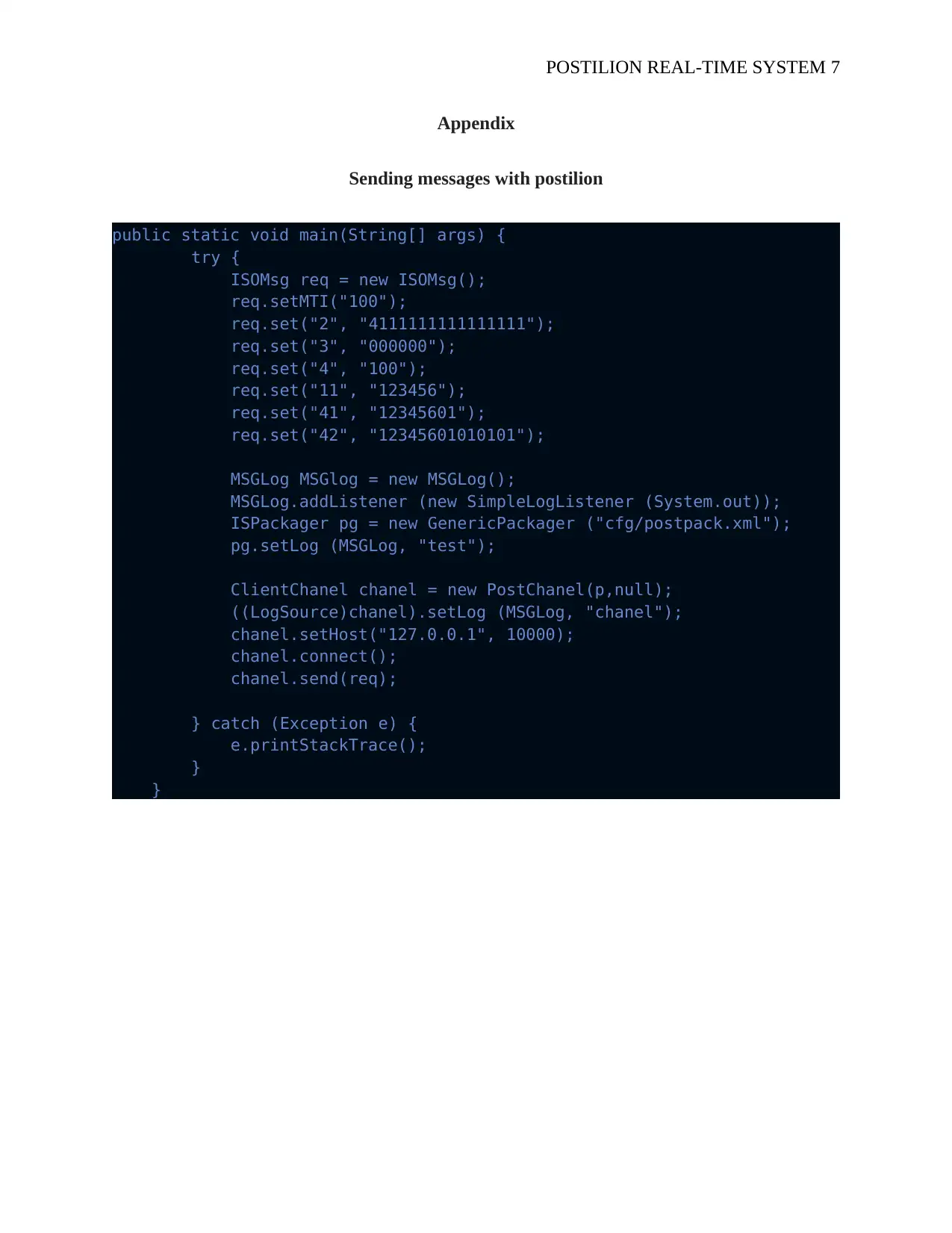
POSTILION REAL-TIME SYSTEM 7
Appendix
Sending messages with postilion
public static void main(String[] args) {
try {
ISOMsg req = new ISOMsg();
req.setMTI("100");
req.set("2", "4111111111111111");
req.set("3", "000000");
req.set("4", "100");
req.set("11", "123456");
req.set("41", "12345601");
req.set("42", "12345601010101");
MSGLog MSGlog = new MSGLog();
MSGLog.addListener (new SimpleLogListener (System.out));
ISPackager pg = new GenericPackager ("cfg/postpack.xml");
pg.setLog (MSGLog, "test");
ClientChanel chanel = new PostChanel(p,null);
((LogSource)chanel).setLog (MSGLog, "chanel");
chanel.setHost("127.0.0.1", 10000);
chanel.connect();
chanel.send(req);
} catch (Exception e) {
e.printStackTrace();
}
}
Appendix
Sending messages with postilion
public static void main(String[] args) {
try {
ISOMsg req = new ISOMsg();
req.setMTI("100");
req.set("2", "4111111111111111");
req.set("3", "000000");
req.set("4", "100");
req.set("11", "123456");
req.set("41", "12345601");
req.set("42", "12345601010101");
MSGLog MSGlog = new MSGLog();
MSGLog.addListener (new SimpleLogListener (System.out));
ISPackager pg = new GenericPackager ("cfg/postpack.xml");
pg.setLog (MSGLog, "test");
ClientChanel chanel = new PostChanel(p,null);
((LogSource)chanel).setLog (MSGLog, "chanel");
chanel.setHost("127.0.0.1", 10000);
chanel.connect();
chanel.send(req);
} catch (Exception e) {
e.printStackTrace();
}
}
1 out of 7
Related Documents
Your All-in-One AI-Powered Toolkit for Academic Success.
+13062052269
info@desklib.com
Available 24*7 on WhatsApp / Email
![[object Object]](/_next/static/media/star-bottom.7253800d.svg)
Unlock your academic potential
Copyright © 2020–2025 A2Z Services. All Rights Reserved. Developed and managed by ZUCOL.





